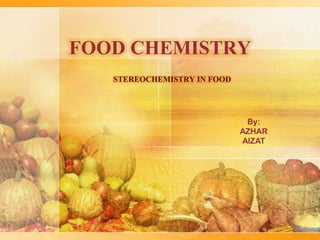
Food chemistry
- 1. FOOD CHEMISTRY STEREOCHEMISTRY IN FOOD By: AZHAR AIZAT
- 2. INTRODUCTION • Chiral carbon atoms - carbon atom that is bonded to four different groups – which bring about two distinct spatial arrangement of molecule, called enantiomers. Similarity • Enantiomers are mirror image of each other, have identical physical and chemical properties
- 3. Differences One of them will rotate the plane of polarization of plane polarized light in a clockwise direction This enantiomer is said to be dextrorotatory (+ or d) and has a positive specific rotation value. Another enantiomer will rotate the plane of polarization of the plane polarized light in an anticlockwise direction. It is said to be laevorotatory (- or l) where it has negative specific rotation value.
- 4. F9.1: Explain the three different conventions used for naming the different enantiometric forms 1) D, L notation • An older convention used for sugar and amino acids. • The absolute configuration of other sugars about each chiral centre is then named by analogy: o If the C=O pointed away, the –OH group on the right then it is a D-isomer. o And if the C=O pointed towards you , the –OH group on the left then it is a L-isomer
- 5. • The D,L system is also applied to amino acids. • Using the “CORN” rule, the “COOH”, “R-side chain group”, “NH2” are around the Carbon atom. • CORN rule: o Molecule is viewed with the C-H bond pointed away from the observer (same as in the R,S system) o Made up of COOH, R and NH2 arrange around the carbon atom. If it is arranged clockwise – D-form If anticlockwise – L-form
- 6. • Almost all naturally occurring amino acids are the L-form and are usually tasteless. • Synthetic D-amino acids taste sweet and most naturally occurring sugars are D-form. • Enantiomers that does do not occur naturally cannot be metabolized by our body. • SUGARS contain an aldehyde or ketone, and all carbons which do not have it is attached to an alcohol. • Amino acids contain carboxylic acid (COOH), Hydrocarbon chain (R) and amino group (NH2)
- 7. 1) R,S system (CIP system) Cahn, Ingold & Prelog • Used for other groups of compounds. • Involve 3 steps: i. Atom bonded to the chiral carbon are ranked in order of increasing atomic number – most common would be (H<C<N<O<F<Cl<Br) ii. When 2 @ more atoms have the same atomic no. (eg: -CH3 & -COOH) , the 2nd atoms are used to rank the substituents (so –COOH >CH3, since atomic no of 3xH < O) . And if the 2nd atom is also the same, then move on the next atom and so on. (remember that double bond count as double - COOH = 3O, since one of O have double bonds. iii. View the double molecule with the lowest ranking is pointing away from you, other three substituent must either decrease in order in a clockwise direction (R-enantiomer) @ in an anti clockwise direction (S-enantiomer)
- 8. F9.2: DISTINGUISH BETWEEN THE PROPERTIES OF ENANTIOMERIC FORMS OF STEREOISOMERS FOUND IN FOOD
- 9. • Enantiomers may be similar but different enantiomeric forms of molecule have different taste smells and toxicity. • This is because biological systems are much more sensitive to the shape of molecule • E.g.: Carvone: R-form= Laevorotatory= has smell and flavour of spearmint. S-form= Dextrarotatory= has the smell and flavour of caraway seeds. Limonene: +(d) = Smells of oranges -(l)= Smells of lemons
- 10. • Sometimes, a natural flavour is a pure enantiomer, because it is biosynthesis tends to stereo specific. • Synthetic equivalence is often a racemix mixture mixture of equal amounts of the enantiomers . (easier to synthesis) • E.g.: alphaionone in raspberries. • As for toxicity it can varies tremendously between the different enantiomer, as become tragically apparent in the Thalidomide disaster.
- 12. Template Provided By www.animationfactory.com 500,000 Downloadable PowerPoint Templates, Animated Clip Art, Backgrounds and Videos
